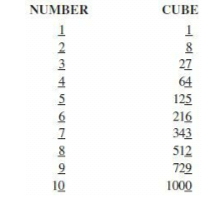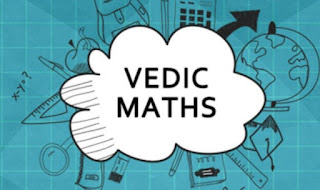VEDIC MATHS-24
VEDIC MATHS
By OMKAR TENDOLKAR
This is blog number 24 from the series of "Vedic maths" blogs. Here in this blog we will learn about "Method for calculating cube root of perfect number"
Calculating cube root of numbers by traditional method is cumbersome procedure, but the technique used by Vedic Mathematics is so fast that one can get the answer in two to three seconds!
The technique for solving cube roots is simply so amazing that the student will be able to correctly predict the cube root of a number just by looking as it and without the need for any intermediate steps.
In this blog, we will learn how to calculate cube-roots. Thus, if you are given the number 8 you will have to arrive at 2. However these are basic examples. We shall be cracking higher order number like 704969, 175616, etc.
At this point, I would like to make a note that the technique provided in this blog can be used to find cube root of perfect cubes only. It can't be used to find the cube root of imperfect cubes.
Method:
I have given below cube of a number from 1 to 10. Before proceeding ahead we have to memorize the list given below because it will help to calculate cube of higher numbers. With the knowledge of these numbers, we shall be able to to solve the cube-roots instantly.
The cube of 1 is 1,
The cube of 2 is 8 and so on....
After memorizing the above list I would like to to draw your attention to the underlined numbers in the list. I have underlined some numbers as they have unique relationship among themselves.
In the first row, underlined numbers are 1 and 1. It establishes a certain relationship that if the last digit of cube is 1 then last digit of cube-root is also 1.
In the second row, underlined numbers are 2 and 8. It establishes a certain relationship that if the last digit of cube is 8 then last digit of cube-root is also 2. Thus, in any given Cube if the last digits of the number is 8 the last digit of it's Cube-root will always be 2.
In the third row, the underlined numbers are 3 and 7 (out of 27 we are interested in the last digit only and hence we have underlined only 7). We can thus conclude that if the last digit of a cube is 7 the last digit of the cube roots is 3.
And like this if we observe the last row where the the last digit of 10 is 0 and last digit of 1000 is also 0. Thus, when cube ends in 0 the cube-root also ends in 0.
On the basis of above observation, we can form a table as given below:
Second thing to be kept in mind before solving Cube-roots:
Whenever a cube is given to you to calculate it's Cube-root, you must put a slash before the last three digits.
If the cube given to you is 103823 you will represent it as 103|823
If the cube given to you is 39304 you will represent it as 39|304
Immaterial of the number of digits in the cube, you will always put a slash before the last three digits.
We will meet very soon through our next blog. Till that stay connected, stay healthy and stay safe.
Thanks
for giving your valuable time.
Good day😊.




Comments
Post a Comment